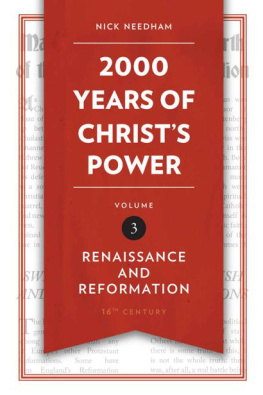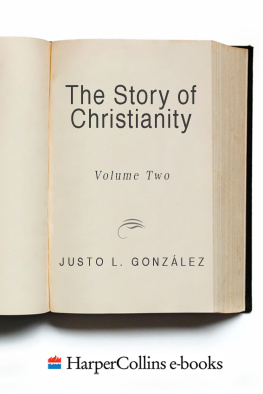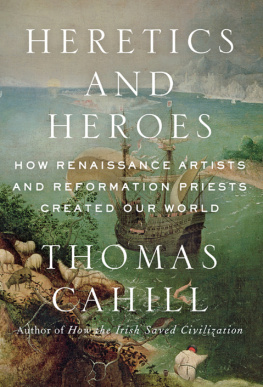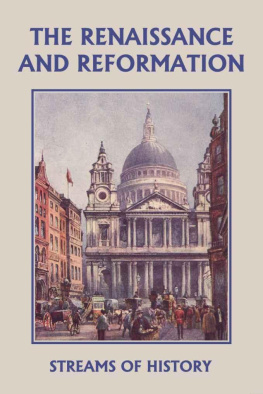Knowledge of church history is vitally important for the health of Christians but sadly too often neglected in a world where lack of interest in history is a hallmark of cultural life in general. Given this neglect, Christians who want to learn about this subject often wonder where they should start. For many years now I have always given the same answer: if you want a thorough, learned but accessible and well-written history of the church, read Nick Needhams 2,000 Years of Christs Power. And now, with the fourth volume finally available, Christians have an excellent resource for improving their knowledge of the history of their faith. Highly recommended.
C arl R. Trueman
Paul Woolley Professor of Church History,
Westminster Theological Seminary, Philadelphia, Pennsylvania
Nick Needhams volumes on church history are exceptional in their coverage, interest and clarity. They explain everything that someone new to the subject might not understand. At the same time, they achieve a depth of detail to interest those who already know something of the subject. The narrative is illuminated by excerpts from primary sources. We use them as standard texts at LTS and look forward eagerly to forthcoming volumes.
R obert Strivens
Principal,
London Theological Seminary, London
It is a brave historian who tackles the extremely challenging task of writing the 2,000-year history of the Church. There is simply so much stuff to read and master. Of course, the benefits are enormous: a unified, consistent, and focused narrative. Well, Nick Needham is such an historian: brave and knowledgeable and he has more than risen to the challenge of the task. The eagerly-awaited fourth volume has been well worth the wait and, not to pressure our brother scholar, we now look forward to the concluding volume that will bring the account to the present day!
M ichael A. G. Haykin
Professor of Church History and Biblical Spirituality,
The Southern Baptist Theological Seminary, Louisville, Kentucky
NICK NEEDHAM
2000
YEARS OF
CHRIST'S
POWER
VOLUME
RENAISSANCE
AND
REFORMATION
Copyright Dr N. R. Needham 2016
hardback ISBN 978-1-78191-780-0
epub ISBN 978-1-78191-918-7
mobi ISBN 978-1-78191-919-4
First published in 2004
reprinted in 2010
Newly revised edition published in 2016
by
Christian Focus Publications Ltd,
Geanies House, Fearn, Ross-shire,
IV20 1TW, Scotland, U.K.
www.christianfocus.com
and
Grace Publications Trust
7 Arlington Way
London, EC1R 1XA, England
www.gracepublications.co.uk
Cover design by Paul Lewis
eBook production by
Oxford eBooks Ltd.
www.oxford-ebooks.com
All rights reserved. No part of this publication may be reproduced, stored in a retrieval system, or transmitted, in any form, by any means, electronic, mechanical, photocopying, recording or otherwise without the prior permission of the publisher or a licence permitting restricted copying. In the U.K. such licences are issued by the Copyright Licensing Agency, Saffron House, 610 Kirby Street, London, EC1 8TS www.cla.co.uk.
Dedication
To the Alliance of Confessing Evangelicals (ACE), who are doing so much among Lutherans and Reformed to stimulate a healthy interest in the Reformation and its ongoing lessons for today
Contents
Renaissance and Reformation
Illustrations and Maps
Acknowledgments
I wish to pay my debt of thanks to the following:
The Samuel Bill Theological College in Abak, Nigeria, whose students were the original inspiration for this work; the late John Appleby, who was instrumental in getting this series off the ground with Grace Publications; John Noble, who produced the indices; Joyce Bell who assisted with proofreading; Phil Arthur and Timothy Grass, fellow Christian historians and co-workers, who each independently read through the entire first draft of this book, and made numerous valuable corrections and suggestions; Father Richard Conrad of Holy Cross Priory, Leicester, who read through and commented helpfully on an early draft of Chapter 8 on the Catholic Counter-Reformation; Father Alexis of the St Edward Brotherhood near Woking, who read through and commented helpfully on the draft of Chapter 9 on Eastern Orthodoxy; Steven Robinson of the Reformed Presbyterian Church of Ireland, presently serving as instructor of Old Testament literature at Westminster Biblical Missions Krolyi Gspr Institute of Theology, Miskolc, Hungary, whose knowledge of the Hungarian Reformation was an indispensable help in the writing of Chapter 6; Alan Howe of Emmanuel Presbyterian Church, Clacton-on-Sea, England and the Alliance of Reformation Christians (ARC), who kindly translated many articles on less well-known Reformers from the German of the excellent Biographisch-Bibliographischen Kirchenlexikon, which can be accessed online at http://www.bbkl.de/; The Evangelical Library for the use of the portraits throughout this book.
A special word of thanks to my friend the Rev. Paul R. Williams of Grace Lutheran Church, Kitchener, Ontario, Canada, a walking encyclopaedia on all things Lutheran (past and present), who amid a busy pastoral life kindly read through the material on Lutheranism and contributed many helpful corrections and suggestions. The Lutheran material makes up a large chunk of the volume, and without Pauls help it would have been immeasurably poorer. Paul is the Lutheran moderator of the LutheranReformed discussion forum at http://groups.yahoo.com/group/Luther-Reform/, participation in which over the past two years has greatly enhanced and enriched my knowledge of Lutheranism.
Introduction
This is the third volume of a series entitled 2000 Years of Christs Power. Two other volumes, on the early Church fathers and the Middle Ages, precede this one. It can, however, be read by itself as an introduction to the Renaissance and the Reformation.
The Protestant Reformation is the most controversial era in the history of the Church. Its legacy of division lives on vibrantly today, with Roman Catholics, Lutherans, Reformed (Calvinists), Anglicans, and Anabaptists still worshipping in different religious communities: often suspicious of each other, more often ignorant of each other. Into the complex picture one can then add the Eastern Orthodox, peering uneasily westward over the walls of Constantinople and Moscow, and shouting in effect, A plague on all your houses!
What Ive attempted here is, in a sense, quite simple: to tell the story of the Reformation as clearly and fairly as I can. Ive tried to tell it colourfully, too; there are few periods in Church history so full of human interest. As I weave my narrative, my hope is that all todays religious descendants of the amazing 16th century eruption will be able to meet and interact with the authentic voices of their epoch-making ancestors in the faith. I havent made any attempt to tone down the divisive nature of the events of the 16th century, nor to offer any presumptuous solutions of my own to its mixed and fragmented legacy. I am as enmeshed in the 16th century inheritance as any Westerner: Reformed by theological conviction, although having a soft spot for Lutheranism. I have little sympathy with that form of ecumenism which relativises, and thereby trivialises, the convictions for which men and women lived and fought and died in the 16th century. That isnt to say I disapprove of deeper understanding among the different religious traditions that claim the name of Christian; I approve heartily. But sometimes, deeper understanding will lead us to appreciate just how deeply we do differ on not a few issues, despite surprising measures of agreement on others. Papering over the cracks in the interests of some ecumenical happy family game, in which sincerity is more highly prized than truth, is not this writers agenda, either as a historian or a Churchman.
Next page







